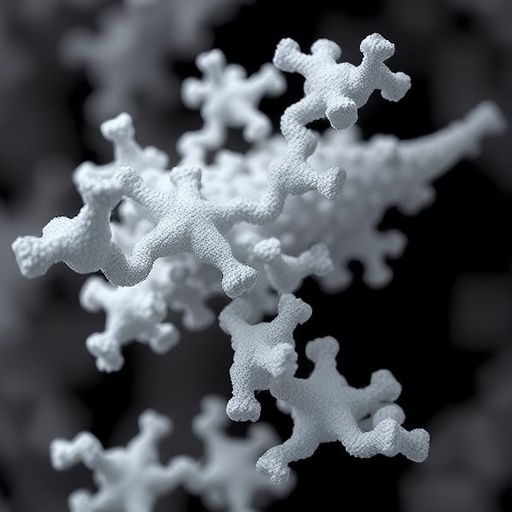A groundbreaking study, soon to be published in the esteemed journal “Nature Machine Intelligence,” delves into the intricate domain of protein structure generation using innovative sparse denoising models. This research, spearheaded by Jendrusch and Korbel, offers a significant leap forward in computational biology and bioinformatics, with the potential to drastically accelerate our understanding of protein folding and functionality. Proteins, often dubbed the workhorses of the cell, are essential for virtually every biological process, ranging from catalyzing metabolic reactions to replicating DNA. Thus, comprehension of their structure is vital for drug discovery, therapeutic interventions, and synthetic biology.
Until recently, predicting the three-dimensional structure of a protein from its amino acid sequence—a phenomenon known as the protein folding problem—remained an elusive challenge for scientists. Traditional methods, such as X-ray crystallography and nuclear magnetic resonance (NMR) spectroscopy, involve cumbersome experimental procedures and extensive time investments, making them less feasible for rapid discoveries. However, machine learning has emerged as a powerful alternative, notably reducing the time and costs associated with protein structure prediction.
At the core of the study is the use of sparse denoising models, which are a class of advanced neural networks designed to effectively generate high-quality protein structures with minimal input noise. These models leverage vast datasets of known protein structures and sequences, learning intricate patterns that inform the folding process. The methodology involves training the model on a myriad of protein data, allowing it to grasp the complex relationships between amino acid configurations and their ensuing three-dimensional shapes.
Sparse denoising models refine this approach by focusing on the most relevant features of the data, effectively filtering out extraneous noise. This efficiency not only expedites the generation of protein structures but also enhances the accuracy of these predictions. The authors demonstrate that their models outperform traditional prediction algorithms, yielding results that are not only faster but notably more reliable. This advancement signals a paradigm shift in how researchers can approach the complexities of protein structure determination.
The implications of this breakthrough extend far beyond mere academic curiosity. Accelerated protein structure generation holds immense potential for various fields, including medicine, biotechnology, and environmental science. For instance, in drug development, the ability to swiftly predict protein structures can significantly shorten the timeline from discovery to market. Pharmaceutical companies could harness this technology to identify new drug targets and optimize existing treatments, paving the way for more effective therapeutic interventions.
Additionally, this research opens doors for new discoveries in synthetic biology—the design of organisms that produce useful substances or perform specific functions. By accurately modeling protein structures, scientists can engineer novel proteins with desired properties, which could lead to advancements in biofuels, materials science, and agricultural productivity. The capacity to customize protein functions could rewrite the rules for how biological systems are designed and manipulated.
Despite the excitement surrounding these findings, researchers emphasize the need for caution. While their models demonstrate remarkable proficiency, they recognize that no computational method is foolproof. The complexity of biological systems means that unexpected interactions or conformations may still arise, emphasizing the importance of continued experimental validation. Thus, merging computational predictions with laboratory experiments will be paramount to ensure robust outcomes in practical applications.
Moreover, the study highlights the necessity for an interdisciplinary approach in the field of protein research. Collaboration between computer scientists, biologists, and chemists will be instrumental in refining these models and expanding their applicability. By pooling insights and techniques from diverse scientific disciplines, the journey toward a more comprehensive understanding of protein behavior and interaction can be greatly accelerated.
As we reflect on the significance of this work, it is evident that the landscape of protein research is evolving. The advent of sparse denoising models illustrates how artificial intelligence can complement traditional biological research, offering new avenues for exploration and discovery. In a world where the complexities of life continue to challenge our understanding, innovative tools like these inspire hope and curiosity, urging scientists to push the boundaries of what is possible.
The research encapsulates an exciting frontier in computational biology, one where the synergy between machine learning and life sciences continues to flourish. As technology progresses and our understanding of protein structures deepens, we are not just witnessing a scientific evolution; we are participating in a revolution that may one day unlock the mysteries of life itself. The capacity to design, predict, and replicate proteins at unprecedented speeds could transform our approach to disease treatment, environmental challenges, and the sustainable production of goods.
In summary, Jendrusch and Korbel’s work is not merely a technical achievement; it represents a new era in how we approach the structure and function of proteins. The efficiency afforded by sparse denoising models promises to bridge gaps within the scientific community, fostering collaboration and innovation. As more researchers adopt these cutting-edge techniques, the potential for groundbreaking discoveries is limitless, ushering in a future where understanding life at the molecular level becomes increasingly attainable.
The outcomes of this study could very well define the next chapter in protein research, characterized by swift advancements and unprecedented insights. As we anticipate further developments in this area, the scientific community remains poised for a wave of exploration that could reshape our understanding of biology and its applications markedly.
With the publication of this study, we stand at the intersection of technology and biology, waiting to see how these advancements will redefine the nature of molecular research. The journey towards unraveling the complexities of life continues, with sparse denoising models paving the way for a future rich in possibilities.
Subject of Research: Protein Structure Generation with Sparse Denoising Models
Article Title: Efficient Protein Structure Generation with Sparse Denoising Models
Article References:
Jendrusch, M., Korbel, J.O. Efficient protein structure generation with sparse denoising models.
Nat Mach Intell 7, 1429–1445 (2025). https://doi.org/10.1038/s42256-025-01100-z
Image Credits: AI Generated
DOI: https://doi.org/10.1038/s42256-025-01100-z
Keywords: Sparse Denoising Models, Protein Structure, Machine Learning, Computational Biology, Protein Folding




